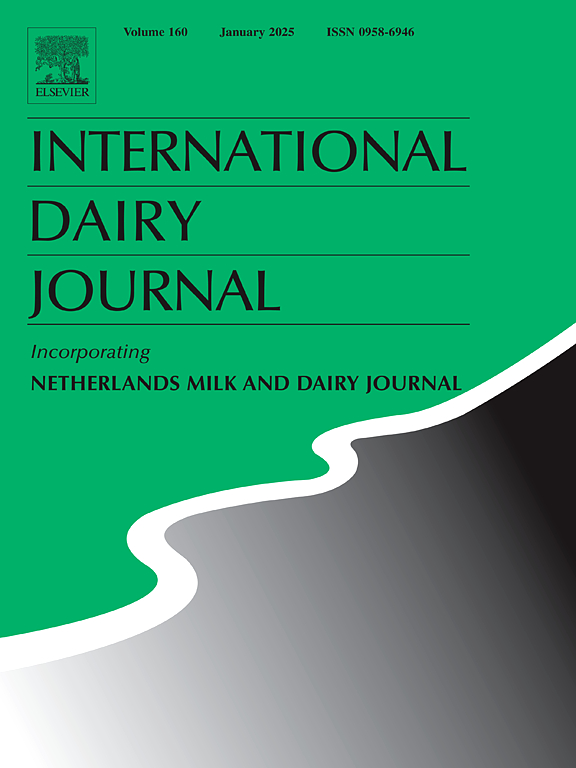乳外泌体微胶囊的制备及其抗环境稳定性研究
IF 3.4
3区 农林科学
Q2 FOOD SCIENCE & TECHNOLOGY
引用次数: 0
摘要
牛乳外泌体(BME)具有免疫调节和抗氧化等功能,在食品和医药领域具有广阔的应用前景。然而,它们在加工、储存和消化环境中缺乏稳定性,严重制约了工业化。本研究以海藻酸钠(SA)和瓜尔胶(GG)为壁材,采用钙离子交联法构建具有保护作用的BME微胶囊化体系。采用响应面法确定最佳包埋参数:GG为0.5% w/v, SA为1.5% w/v, CaCl2为4%,包埋率为91.32±0.32%。表征结果表明,SA-GG-BME微胶囊具有致密的网状结构,微胶囊具有优异的持水性能、结构性能和ph响应膨胀性能。反相实验表明,sa - mg - bme微胶囊与游离牛乳外泌体(free- bme)相比,稳定性显著提高:模拟体外胃肠消化6 h后,蛋白质和RNA保留率分别为75%和45%,在65℃/30 min下,热处理组巨噬细胞代谢活性达到145.19±0.42%(而游离组为137.50±0.73%);0.05), SA-GG-BME微胶囊在4℃贮藏28 d后表现出良好的持水性能和ph响应性膨胀性能,微胶囊具有致密的网状结构。4℃贮藏28 d后,SA-GG-BME组的活性成分比Free-BME组高12-14倍。巨噬细胞促进代谢活性(120.37±0.57%)显著优于SA-BME组(105.09±0.73%)和Free-BME组(无活性)(P <;0.05)。通过揭示SA-GG壁材的氢键-疏水协同保护机制,为BME在功能性乳制品及口服靶向配方中的应用提供理论依据。本文章由计算机程序翻译,如有差异,请以英文原文为准。
Preparation of encapsulated bovine milk exosome microcapsules and their resistance to environmental stability
Bovine milk exosomes (BME) have great potential for application in food and medicine due to their functional activities, such as immunomodulation and antioxidants. Still, their lack of stability in processing, storage, and digestive environments seriously restricts industrialization. In this study, sodium alginate (SA) and guar gum (GG) were used as wall materials to construct a BME microencapsulation system with a protective effect by the calcium ion cross-linking method. The optimized embedding parameters were determined by response surface methodology as 0.5 % w/v for GG, 1.5 % w/v for SA, and 4 % for CaCl2, which achieved an encapsulation efficiency rate of 91.32 ± 0.32 %. Characterization results showed that the SA-GG-BME microcapsules had a dense network structure, and the microcapsules exhibited excellent water-holding and textural properties as well as pH-responsive swelling properties. Inverse experiments showed that SA-GG-BME microcapsules significantly improved stability compared with free-bovine milk exosomes (Free-BME): protein and RNA retention were 75 % and 45 % after simulated in vitro gastrointestinal digestion for 6 h, Macrophage metabolic activity reached 145.19 ± 0.42 % in the heat-treated group at 65 °C/30 min (vs. 137.50 ± 0.73 % in the free group, P < 0.05), and the SA-GG-BME microcapsules exhibited excellent water holding properties and pH-responsive swelling properties after storage at 4 °C for 28 d. The microcapsules had a dense network structure. After 28 d of storage at 4 °C, the active components in the SA-GG-BME group were 12–14 times higher than those in the Free-BME group. The macrophage-promoting metabolic activity (120.37 ± 0.57 %) was significantly better than that of the SA-BME group (105.09 ± 0.73 %) vs. the Free-BME group (inactive) (P < 0.05). By revealing the hydrogen bonding-hydrophobic synergistic protection mechanism of SA-GG wall materials, the present study provides a theoretical basis for applying BME in functional dairy products and orally targeted formulations.
求助全文
通过发布文献求助,成功后即可免费获取论文全文。
去求助
来源期刊

International Dairy Journal
工程技术-食品科技
CiteScore
6.50
自引率
9.70%
发文量
200
审稿时长
49 days
期刊介绍:
The International Dairy Journal publishes significant advancements in dairy science and technology in the form of research articles and critical reviews that are of relevance to the broader international dairy community. Within this scope, research on the science and technology of milk and dairy products and the nutritional and health aspects of dairy foods are included; the journal pays particular attention to applied research and its interface with the dairy industry.
The journal''s coverage includes the following, where directly applicable to dairy science and technology:
• Chemistry and physico-chemical properties of milk constituents
• Microbiology, food safety, enzymology, biotechnology
• Processing and engineering
• Emulsion science, food structure, and texture
• Raw material quality and effect on relevant products
• Flavour and off-flavour development
• Technological functionality and applications of dairy ingredients
• Sensory and consumer sciences
• Nutrition and substantiation of human health implications of milk components or dairy products
International Dairy Journal does not publish papers related to milk production, animal health and other aspects of on-farm milk production unless there is a clear relationship to dairy technology, human health or final product quality.
 求助内容:
求助内容: 应助结果提醒方式:
应助结果提醒方式:


